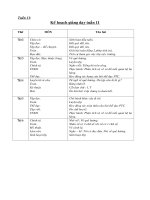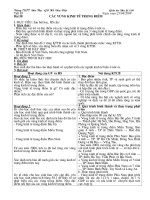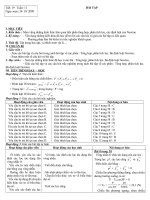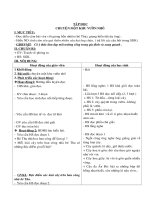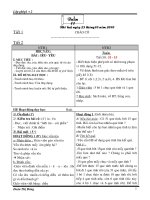GIÁO ÁN 9 THI DIEM- TUẦN 11
Bạn đang xem bản rút gọn của tài liệu. Xem và tải ngay bản đầy đủ của tài liệu tại đây (115.12 KB, 9 trang )
<span class='text_page_counter'>(1)</span><div class='page_container' data-page=1>
<b>Date of preparing:25/10/2018 Period: 29 </b>
<b>UNIT 4: LIFE IN THE PAST</b>
<b>LESSON 4 : COMMUNICATION (P. 31)</b>
<b>A. OBJECTIVES: </b>
- By the end of the lesson, students will be able to get more knowledge about life in the
past.
+ Vocabulary:
+ Grammar:
- Skills: Practice and develop reading and writing skills.
- Political thought and moral sense: educate students to know more about life in the past
and love learning English.
<b>B. TEACHING AIDS: </b>
- Textbook, teacher’s book, lesson plan, board, chalks and the projector.
<b>C. METHODS: </b>
Comprehension question, gap-fill, match and discussion.
<b>D. CONTENTS: </b>
<b>I. Organization: (1 minute)</b>
<b>II. Revision: (5 minutes)</b>
<i><b>* Checking old lesson</b></i>
- T calls on 3 students to do exercise B 1,2,3 on page 31, 32 workbook.
- Other Ss and T gives remark and marks.
<b>III. New lesson: (37 minutes)</b>
<i><b>Activity 1. Discussion (Part 1/ p.45) (7 minutes)</b></i>
- T writes “Looking back” on the BB and leading Ss through the discussion of the
questions.
- Encourage Ss to give any or all ideas, there are no wrong answers at ths stage.
- T shows 3 questions on the board and runs through.
- Before Ss read the passage, check their understanding of the words in the Extra
vocabulary box.
- T shows extra vocabulary on the BB.
- T explain the following words:
downtown (adv) vào trung tâm thành phố
remote (n): xa xôi
igloo (v): lều tuyết
domed (adj): hình vịm
Arctic (adj): thuộc về Bắc Cực
</div>
<span class='text_page_counter'>(2)</span><div class='page_container' data-page=2>
- Ss do the task in pairs.
- T gets Ss’ ideas.
<i><b>Activity 2. Gap-fill (Part 2/ p.45) (7 minutes)</b></i>
- T shows the poster which has the contents of part 2/ p.45 on the board then runs
through.
- T gives the instructions: Read the stories and find the words which mean as given
phrases.
- T models the first one.
1. illiterate
- T checks Ss’ understanding.
- Ask Ss to work in pairs to complete the task in about 2 minutes.
- T gets Ss’ answers by dividing the class into 2 groups. One by one student from each
group comes to the board and writes the answer.
- T controls, corrects, gives marks then praises the winner.
<i><b>+ Answer key: </b></i>
1. illiterate 2. pass on 3. treat someone 4. block 5. survive 6. dogsled
<i><b>Activity 3. </b><b> Comprehension questions (Part 3/ p.45) (7 minutes)</b></i>
- T shows the poster which has the contents of part 3/ p.45 on the board then runs
through.
- T gives the instructions: Read the stories and answer the questions:
- T models the first one.
1.It was difficult to reach the villagers on the mountain./
There were no other means of transport available.
- T checks Ss’ understanding.
- Ask Ss to work in pairs to complete the task in about 2 minutes.
- T gets Ss’ answers by dividing the class into 2 groups. One by one student from each
group comes to the board and writes the answer.
- T controls, corrects, gives marks then praises the winner.
<i><b>+ Answer key: </b></i>
1. It was difficult to reach the villagers on the mountain./
There were no other means of transport available.
2. There were no school in the villages./
The nearest school might be too far away.
3. There were no other materials available in that deserted land./
There were no easy means to transport materials from other places to the island.
4. It was impossible to build a big house with several rooms in the ice and snow./
</div>
<span class='text_page_counter'>(3)</span><div class='page_container' data-page=3>
<i><b>Activity 4. Match (Part 4/ p.45) (7 minutes)</b></i>
- T shows the poster which has the contents of part 4/ p.45 on the board then runs
through.
- T gives the instructions: Match the responses with the stories.
- T models the first one.
Story 1: 2
- T checks Ss’ understanding.
- Ask Ss to work in pairs to complete the task in about 2 minutes.
- T gets Ss’ answers.
- T checks and corrects.
<i><b>+ Answer key: </b></i>
Story 1: 2, 4
Story 2: 1, 3, 5
<i><b>Activity 5. Discussion (Part 5/ p.45) (7 minutes)</b></i>
- T asks Ss to work in small groups and work out a story for looking back competition.
- Make sure Ss include the necessary information in the story.
Decide:
What aspect of life you want to talk about
How it was practised
If you wish it would still be practised
- Each group then presents the story to the class.
- The rest of the class can ask questions about the topic.
<b>IV. Summary: (1 minute)</b>
- T asks students to repeat the main contents of the lesson.
<b>V. Homework: (1 minute)</b>
- Do the exercises: C / p34,35in workbook.
- Prepare the new lesson: Unit 4: Lesson 5: Skills 1
<b>E. EVALUATION: </b>
...
...
...
...
</div>
<span class='text_page_counter'>(4)</span><div class='page_container' data-page=4>
<b>---Date of preparing:25/10/2018 Period: 30</b>
<b>UNIT 4: LIFE IN THE PAST</b>
<b>LESSON 5: SKILLS 1 (P. 46)</b>
<b>A. OBJECTIVES: </b>
- By the end of the lesson, students will be able to read for specific information about the
way teenagers entertain themselves nowadays compared to the past.
+ Vocabulary:
+ Grammar:
- Skills: develop and practise reading and speaking skills.
- Political thought and moral sense: educate students to know more about the way
teenagers entertain themselves nowadays compared to the past and love learning English
more.
<b>B. TEACHING AIDS:</b>
- Textbook, teacher’s book, lesson plan, board, chalks, posters, CD and cassette.
<b>C. METHODS: </b>
- Presentation text, comprehension questions and dicussion.
<b>D. CONTENTS: </b>
<b>I. </b>
<b> Oganization: (1 minute)</b>
<b>II. Revision/ Warmer: (5 minutes)</b>
<i><b>* Brainstorming</b></i>
- T draws the net on the board.
- T gives the instructions: write down as many activities teenagers entertain nowadays as
possible.
- T models the first one.
watch TV
- T checks Ss' understanding.
- Ss think and prepare in about 1 minute.
- T divides the class into 2 groups. T gives the name -> checks
- One by one student from each group comes to the board and writes one answer.
- T corrects, then praises the winner.
<i><b>+ Possible answers: </b></i>
Watch TV, listen to music, use Internet, use Ipad, chat online…
<b>III. New lesson : (37 minutes)</b>
<i><b>* Reading (20 minutes)</b></i>
<i><b>Activity 1</b><b> . Discussion (Part 1/ p.46)</b><b> . </b></i>
</div>
<span class='text_page_counter'>(5)</span><div class='page_container' data-page=5>
- T shows two pictures in reading part and ask Ss the questions:
1. How different is the way teenagers entertain themselves nowadays compared to the
past?
2. What do you think might be the biggest different?
- Ss work in groups of 4 to discuss.
- T gets Ss’ answers on the BB.
<i><b>Activity 2. Comprehension questions ( part 2/ p. 46)</b></i>
- T shows the content in part 2/p.46 on the board then runs through.
- T gives the instructions: Read the passage again and anwer the questions.
- T models:
1. They used to play outdoors, in the fresh air.
- T checks Ss’ understanding.
- Ss work individually
- Ss can underline parts of the text that help them with the answers then compare with
their partners in about 1 minutes.
- T gets Ss’ answers then corrects.
<i><b>+ Answer key: </b></i>
1. They used to play outdoors, in the fresh air.
2. They met and talked face-to-face.
3. It kept them healthy and in shape.
4. At home.
5. You had to use your own imagination.
6. No, they didn’t.
<i><b>* Speaking (17 minutes)</b></i>
<i><b>Activity 3. Discusion ( part 3/ p. 46)</b></i>
- Ask Ss to read the examlpe in 3 and the expressions for opinions and comments in the
REMEMBER! Box at the bottom of the page.
- Once they are clear about what they have to do, they can read each pastime in the list
and discuss they think about it in groups of three or four.
- T should move around the groups and offer guidance.
Pastimes:
1. doing physical activites in the fresh air.
2. using nature as your playground.
3. meeting and talking face-to-face
4. reading
</div>
<span class='text_page_counter'>(6)</span><div class='page_container' data-page=6>
- Apart form expressing an opinion on a practice in the past, Ss have to decide whether
they would like to keep the practice alive and explain why.
- Allow Ss some time to read the practices, make their decision, and think of the reasons
for the discussions.
- If something interesting in expressed, T may wish to bring the whole class together to
discuss it.
1. hand-written homework
2. playing trditional games like hike-and-seek, elastic-band jumping,
skipping, and catch the chickens
3. crossing one’d hands in front of and bowing when you greet a person of
seniority.
4. obeying your parents/ teachers without talking back.
<b>IV. Summary (1 minute)</b>
- T asks students to repeat the main contents of the lesson.
<b>V. Homework: (1 minute)</b>
- Do the exercises in part D in the workbook P. 35,36
- Prepare the new lesson: Unit 4: Lesson 6: Skills 2.
<b>E. EVALUATION:</b>
...
...
...
……….
<b>Date of preparing:25/10/2018 Period: 31 </b>
<b>UNIT 4: LIFE IN THE PAST</b>
<b>LESSON 6: SKILLS 2 (P. 47)</b>
<b>A. OBJECTIVES: </b>
- By the end of the lesson, students will be able to listen to get specific information about
an old man’s school day and write a short description of how students in the past studied
without a facility which was not available 20 years ago.
+ Vocabulary:
+ Grammar:
- Skills: develop and practice listening and writing skills.
- Political thought and moral sense: educate students to know more about asking and
giving advice and love English more.
<b>B. TEACHING AIDS:</b>
</div>
<span class='text_page_counter'>(7)</span><div class='page_container' data-page=7>
- Brainstorming, T/F statements, gap-fill, pair work, write-it-up.
<b>D. CONTENTS: </b>
<b>I. Organization: (1 minute)</b>
<b>II. Revision / Warmmer: (5 minutes)</b>
<i><b>* Brainstorming</b></i>
- T draws the net on the board.
- T gives the instructions: write down as many wonders of Viet Nam as possible.
- T models the first one.
computer
- T checks Ss' understanding.
- Ss think and prepare in about 1 minute.
- T divides the class into 2 groups. T gives the name -> checks
- One by one student from each group comes to the board and writes one answer.
- T corrects, then praises the winner.
<i><b>+ Possible answers: </b></i>
Computer, internet, wifi access, Ipad, board, pen, books, pencil, marker, radio, TV…
<b>III. New lesson : (37 minutes)</b>
<i><b>* Listening. (20 minutes)</b></i>
<i><b>Activity 1: T/F statements ( part 1/ p. 47 ) </b></i>
- T shows the poster which has the content of part 1/ p.47, then runs through.
- T gives the instructions: An old man is talking about his school days. Listen and decide
if the statements are true or false, or not given.
- T checks Ss’ understanding.
- T plays the recording twice.
- Ss work individually.
- Ss compare with their partners in about 1 minutes.
- T gets Ss’ answers then corrects.
<i><b>+ Answer key:</b></i>
1. F 2. T 3. T 4. NG 5. F 6.T
<i><b>Activity 2. Gap-fill ( part 2/ p. 47)</b></i>
- T shows the content in part 2/p.33 on the board then runs through.
- T gives the instructions: Listen again and fill in the blanks.
- T checks Ss’ understanding.
- Ss work individually
</div>
<span class='text_page_counter'>(8)</span><div class='page_container' data-page=8>
- Ss can underline parts of the text that help them with the answers then compare with
their partners in about 1 minutes.
- T gets Ss’ answers then corrects.
<i><b>+ Answer key: </b></i>
1. 15 2. bare-footed 3. maths, history
4. strick rules 5. extra classes
<i><b>* Writing. (17 minutes)</b></i>
<i><b>Activity 3: Pair work ( part 3/ p.33 ).</b></i>
- T shows 2 pictures and the poster which has the contents of part 3/ p.47 on the board
then runs through.
- T gives the instructions: Look at the list of the facilities you are using for your studies
nowadays. Then tick the ones you think were not available about 20 years ago.
- T models the first one.
1. Internet
- T checks Ss’ understanding.
- Ss work in pairs for this task.
- T gets Ss’ answers, checks and corrects.
<i><b>+ Answer key: </b></i>
1. Internet 2. Ipad 3. smart phone 4. computer
<i><b>Activity 4: Write-it-up ( Part 4 p. 33)</b></i>
- T asks Ss to choose one facility which was not available about 20 years ago and write a
short description of how students in the past studied without that facility.
In your writing, you should include:
What facility it is
What it is used for
How students did the job in the past when they didn’t have it
How you feel about the change
- T checks Ss’ understanding.
- Ss work individually to complete the task.
- Ss swap their writing for peer correction.
- T goes around to see and helps Ss.
- T collects some Ss’ paper and mark them, then give comments to the class.
<b>IV. Summary.</b><i><b> (1 minute)</b></i>
<i><b>- T asks students to repeat the main contents of the lesson. </b></i>
<b>V. Homework: (1 minute)</b>
- Finish all exercises at home.
</div>
<span class='text_page_counter'>(9)</span><div class='page_container' data-page=9>
- Prepare the new lesson: Unit 4: Lesson 7: Looking back + project.
<b>E. EVALUATION:</b>
...
...
...
</div>
<!--links-->
